Sound/GRO 5-4-0 fert
nwrose
15 years ago
Related Stories

GARDENING GUIDESGreat Design Plant: Rhus Aromatica ‘Gro-Low’ Handles Many Tough Sites
Plant ‘Gro-Low’ fragrant sumac in eastern and midwestern U.S. gardens for its tolerance of tough sites, spreading form and orange fall color
Full Story
GREEN BUILDINGHouzz Tour: See a Concrete House With a $0 Energy Bill
Passive House principles and universal design elements result in a home that’ll work efficiently for the long haul
Full Story
MOST POPULAR5 Ways to Hide That Big Air Conditioner in Your Yard
Don’t sweat that boxy A/C unit. Here’s how to place it out of sight and out of mind
Full Story
LIFEThe Top 5 Ways to Save Water at Home
Get on the fast track to preserving a valuable resource and saving money too with these smart, effective strategies
Full Story
HOUZZ CALLHouzz Call: Show Us Your 8-by-5-Foot Bathroom Remodel
Got a standard-size bathroom you recently fixed up? We want to see it!
Full Story
GARDENING GUIDES5 Weed-Smothering Ground Covers
Let these landscape plants do the dirty work of choking out weeds while you sit back and enjoy the view
Full Story
FLOORS5 Benefits to Concrete Floors for Everyday Living
Get low-maintenance home flooring that creates high impact and works with home styles from traditional to modern
Full Story
STORAGE5 Tips for Lightening Your Closet’s Load
Create more space for clothes that make you look and feel good by learning to let go
Full Story
CURB APPEAL5 Bright Palettes for Front Doors
Splash bold green, blue, orange or red on your front door, then balance it with a more restrained hue on the rest of the house
Full Story
BATHROOM DESIGN5 Common Bathroom Design Mistakes to Avoid
Get your bath right for the long haul by dodging these blunders in toilet placement, shower type and more
Full Story






jwr6404
Embothrium
Related Professionals
Roxbury Crossing Landscape Architects & Landscape Designers · Billerica Landscape Contractors · Chattanooga Landscape Contractors · Golden Landscape Contractors · Hurricane Landscape Contractors · Muttontown Landscape Contractors · North Ridgeville Landscape Contractors · San Rafael Landscape Contractors · West Allis Landscape Contractors · Ansonia Landscape Contractors · Palo Alto Fence Contractors · Short Pump Fence Contractors · Ventura Fence Contractors · La Mirada Fence Contractors · North Bellport Outdoor Lighting & Audio Visual Systemstj_fircrest
Embothrium
gardengal48 (PNW Z8/9)
Embothrium
gardengal48 (PNW Z8/9)
Embothrium
gardengal48 (PNW Z8/9)
muddydogs
Embothrium
cherylco
gardengal48 (PNW Z8/9)
Embothrium
muddydogs
gardengal48 (PNW Z8/9)
sunnybunny
sunnybunny
sunnybunny
sunnybunny
Embothrium
sunnybunny
Embothrium
sunnybunny